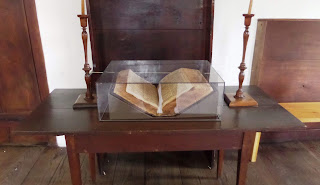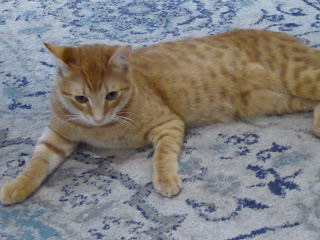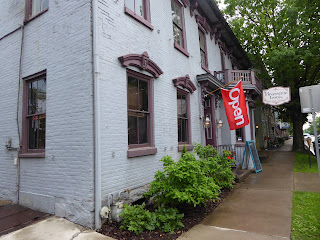I never knew kayaking could be so much fun
until I tried it. Now I’m hooked and am looking forward to my next excursion,
thanks to my enjoyable experience learning about an important era in history
while paddling through Mallows Bay on the Potomac River. The 14-square mile
area, located in Charles County Maryland, is well within sight of Quantico
Marine Base and located in Nanjemoy.
My friends warned me that I’d get wet and cautioned against
taking along a camera. For once, I wished I hadn’t listened. But for a small
splash from the paddles, I emerged dry thanks to the soft launch located
onsite. My seasoned kayak buddy knew better and carted his camera along to
capture at a few moments of the memorable trip.
From April through October, Atlantic Kayak guides join other
kayakers to lead the way and share the story of “The Ghost Fleet of Mallows
Bay.” Guests glide among the decaying detritus of wooden steamships and learn
that the structures were once part of a national effort dating back to WWI when
Woodrow Wilson approved one of the largest and most expensive shipbuilding
programs in history. Because time was of the essence, the hastily and shoddily
constructed ships were rendered almost obsolete from the onset, yet work
continued well after the war ended to fulfill already agreed-upon contracts.
 |
| Egrets build huge nests amidst the rotting remains of WWI warships. (Photo: Courtesy of Reed Hellman) |
Years later, the government sold what was left of an
outmoded fleet to Western Marine and Salvage Company of Alexandria, Virginia
for a grand total of $750,000—the cost of one boat. The company proceeded to extract
the valuable metal and burn the hulls to the waterline to assist in the process.
Before work was complete, the company claimed bankruptcy and today visitors can
safely kayak through the rotting remains.
Reed Hellman, who first visited the Bay in the 1970s as part
of his job as field technician for the then-named Maryland Department of
Chesapeake Bay Affairs, said that time has taken its toll. “When I first
visited, many of the hulls were still intact and above the waterline.” Hellman,
who returned to the site recently, said, “It was much easier to get into the
heart of the fleet this time.”
Hellman highly recommends the trip. “Experiencing it from
the vantage of a tiny kayak opens wide a window into the history of one of our
nation’s first attempts to function as a global power. We undertook building
the ships that now molder in Mallows Bay as an effort to answer our allies
desperate call for help in wartime. That the effort failed was a result of
circumstances, not our country’s will to succeed. For me, Mallows Bay stands as
a monument to our nation’s evolving role in the world.”
 |
| A photo taken during my kayak trip. (Photo: Courtesy, Reed Helman) |
Don Shomette, author of “The Ghost Fleet of Mallows Bay,”
has been hard at work to ensure that the site gets the recognition it deserves. The marine historian has been taking steps
help the area achieve designation as a national marine sanctuary.
In 2014, NOAA invited communities across the nation to nominate their most treasured places in the country's marine and Great Lakes waters for consideration as national marine sanctuaries. "With my colleagues, I was able to assemble a team to reach out to public and private institutions, individuals, historians, colleges and museums to complete a proposal. The major step was to get organized, then engage the public,” said Shomette. Shomette said another step included generating hundreds of pages of documentation to prove that the site deserved a listing on the National Register as an historic and archeological district.
 |
| World War I Warships as they once appeared in Mallow's Bay in 1925. (Photo credit: Don Shomette) |
 |
| An aerial photo of Mallow's Bay (Photo credit: Marine Robotics and Remote Sensing, Duke University) |
 |
| Kayakers paddle along in Mallow's Bay. (Photo credit: Kimberly Hernandez, MDNR, Chesapeake and Coast Service) |
Today Shomette is confident that the site will soon gain the
sought-after recognition. He describes the reaction of Dr. Jim Delgado, former Director of the National Oceanic and Atmospheric Administration’s (NOAA)
Maritime Heritage Program. “When I handed him my archeological report, he was
speechless.”
All I know is that this first-time kayaker was plunked down
into a very special experience, from the history of the area, to the beauty of
the wildlife. More than 100 species of birds nest there and cohabit with other
creatures like river otter and beavers. I felt fortunate to witness eagles soaring
overhead and osprey constructing huge nests on the peaceful wreckage that was
once intended for an entirely different purpose.
 |
| An eagle surveys its surroundings. (Photo credit: Paula Shiller, courtesy of MDNR) |
 |
| An Osprey pair nest atop a ship. (Photo credit: Daryl Byrd, courtesy of MDNR) |
Jody Hedeman Couser, Director of the Chesapeake Conservancy,
is hoping that more people will take an interest in visiting the area as it
continues the journey towards national recognition.
“Mallows Bay has the largest collection of historic
shipwrecks in the Western Hemisphere and they are full of wildlife. The
Chesapeake Conservancy is proud to be a lead partner in the steering committee
seeking the designation and we’re thrilled that Mallows Bay is just a step
closer towards becoming the first National Marine Sanctuary designated in more
than 20 years and the first ever in the Chesapeake,” she said.






























































